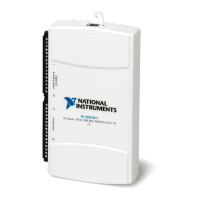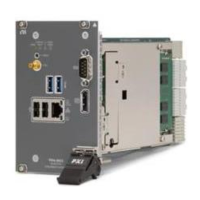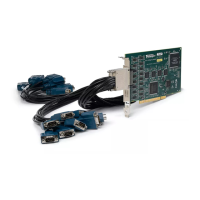© National Instruments | 3-35
NI 6612 User Manual
Channel Settings
By default, the counter outputs the pulses on a default PFI terminal. Refer to Chapter 5,
Counter
Signal Routing and Clock Generation
, for more information
You can change the output terminal by using the CO.Pulse.Term DAQmx Channel property.
Timing Settings
For this type of generation use Sample Clock timing by calling the DAQmx Timing (Sample
Clock) VI or function.
Triggering Settings
By default, the NI 6612 begins generating the pulses when you call the DAQmx Start Task VI
or function. The NI 6612 can also begin generating pulses in response to a digital trigger.
To use a start trigger, call the DAQmx Start Trigger (Digital Edge) VI or function. Inputs to this
VI or function include:
• Source—Specifies which terminal to use as the Start Trigger signal.
• Edge—Specifies rising or falling edges.
The following DAQmx Trigger properties configure the Start Trigger:
• Start.Delay, Start.DelayUnits—Specifies the delay from when the trigger occurs to when
the NI 6612 begins generating pulses.
Note Even if the Start.Delay is set to 0, the NI 6612 inserts a minimum delay equal
to two ticks of the counter timebase.
• Start.DigEdge.DigFltr.Enable, Start.DigEdge.DigFltr.MinPulseWidth—Enables and
Configures a digital filter on the start trigger input. This filter eliminates noise on the start
trigger signal. Refer to Chapter 4,
PFI, for more information.
Buffer Considerations
DAQmx supports configuring and using the waveform buffer in different ways to support a wide
variety of applications. For example, you can configure DAQmx to:
• read data from the buffer once and stop.
• read data from the buffer multiple times (or continuously).
• update the buffer while the device is generating waveforms.
Refer to the Buffering topic in the NI-DAQmx Help for more information.

